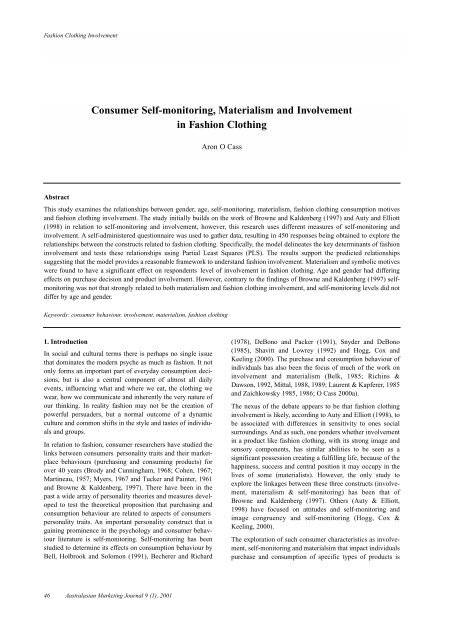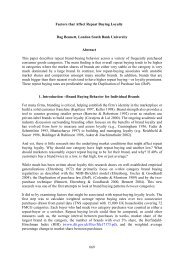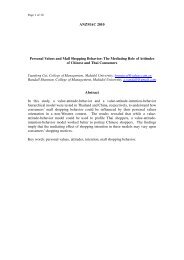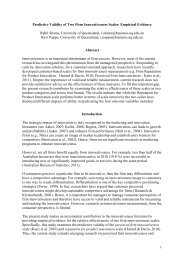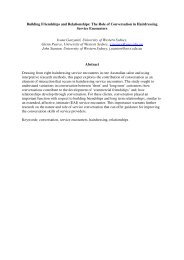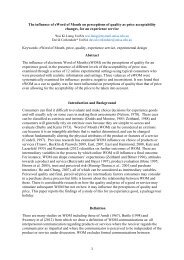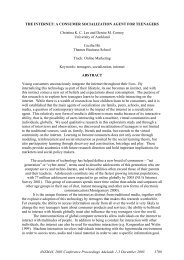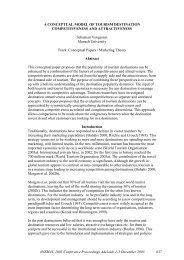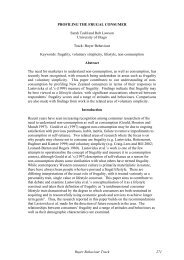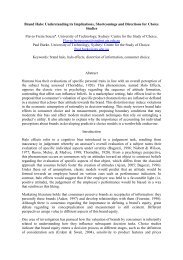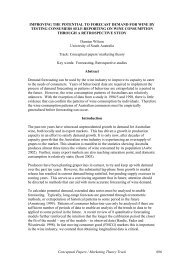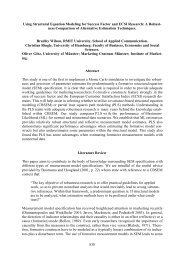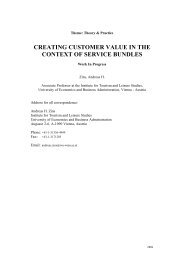amj Australasian Marketing Journal - ANZMAC
amj Australasian Marketing Journal - ANZMAC
amj Australasian Marketing Journal - ANZMAC
Create successful ePaper yourself
Turn your PDF publications into a flip-book with our unique Google optimized e-Paper software.
Fashion Clothing Involvement<br />
Consumer Self-monitoring, Materialism and Involvement<br />
in Fashion Clothing<br />
1. Introduction<br />
In social and cultural terms there is perhaps no single issue<br />
that dominates the modern psyche as much as fashion. It not<br />
only forms an important part of everyday consumption decisions,<br />
but is also a central component of almost all daily<br />
events, influencing what and where we eat, the clothing we<br />
wear, how we communicate and inherently the very nature of<br />
our thinking. In reality fashion may not be the creation of<br />
powerful persuaders, but a normal outcome of a dynamic<br />
culture and common shifts in the style and tastes of individuals<br />
and groups.<br />
In relation to fashion, consumer researchers have studied the<br />
links between consumers personality traits and their marketplace<br />
behaviours (purchasing and consuming products) for<br />
over 40 years (Brody and Cunningham, 1968; Cohen, 1967;<br />
Martineau, 1957; Myers, 1967 and Tucker and Painter, 1961<br />
and Browne & Kaldenberg, 1997). There have been in the<br />
past a wide array of personality theories and measures developed<br />
to test the theoretical proposition that purchasing and<br />
consumption behaviour are related to aspects of consumers<br />
personality traits. An important personality construct that is<br />
gaining prominence in the psychology and consumer behaviour<br />
literature is self-monitoring. Self-monitoring has been<br />
studied to determine its effects on consumption behaviour by<br />
Bell, Holbrook and Solomon (1991), Becherer and Richard<br />
46 <strong>Australasian</strong> <strong>Marketing</strong> <strong>Journal</strong> 9 (1), 2001<br />
Aron O Cass<br />
Abstract<br />
This study examines the relationships between gender, age, self-monitoring, materialism, fashion clothing consumption motives<br />
and fashion clothing involvement. The study initially builds on the work of Browne and Kaldenberg (1997) and Auty and Elliott<br />
(1998) in relation to self-monitoring and involvement, however, this research uses different measures of self-monitoring and<br />
involvement. A self-administered questionnaire was used to gather data, resulting in 450 responses being obtained to explore the<br />
relationships between the constructs related to fashion clothing. Specifically, the model delineates the key determinants of fashion<br />
involvement and tests these relationships using Partial Least Squares (PLS). The results support the predicted relationships<br />
suggesting that the model provides a reasonable framework to understand fashion involvement. Materialism and symbolic motives<br />
were found to have a significant effect on respondents level of involvement in fashion clothing. Age and gender had differing<br />
effects on purchase decision and product involvement. However, contrary to the findings of Browne and Kaldenberg (1997) selfmonitoring<br />
was not that strongly related to both materialism and fashion clothing involvement, and self-monitoring levels did not<br />
differ by age and gender.<br />
Keywords: consumer behaviour, involvement, materialism, fashion clothing<br />
(1978), DeBono and Packer (1991), Snyder and DeBono<br />
(1985), Shavitt and Lowrey (1992) and Hogg, Cox and<br />
Keeling (2000). The purchase and consumption behaviour of<br />
individuals has also been the focus of much of the work on<br />
involvement and materialism (Belk, 1985; Richins &<br />
Dawson, 1992, Mittal, 1988, 1989; Laurent & Kapferer, 1985<br />
and Zaichkowsky 1985, 1986; O Cass 2000a).<br />
The nexus of the debate appears to be that fashion clothing<br />
involvement is likely, according to Auty and Elliott (1998), to<br />
be associated with differences in sensitivity to ones social<br />
surroundings. And as such, one ponders whether involvement<br />
in a product like fashion clothing, with its strong image and<br />
sensory components, has similar abilities to be seen as a<br />
significant possession creating a fulfilling life, because of the<br />
happiness, success and central position it may occupy in the<br />
lives of some (materialists). However, the only study to<br />
explore the linkages between these three constructs (involvement,<br />
materialism & self-monitoring) has been that of<br />
Browne and Kaldenberg (1997). Others (Auty & Elliott,<br />
1998) have focused on attitudes and self-monitoring and<br />
image congruency and self-monitoring (Hogg, Cox &<br />
Keeling, 2000).<br />
The exploration of such consumer characteristics as involvement,<br />
self-monitoring and materialsim that impact individuals<br />
purchase and consumption of specific types of products is


